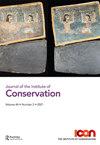Targeting specialist skills through Work-Integrated Learning: a case study in frames conservation at the Art Gallery of New South Wales
IF 1
0 HUMANITIES, MULTIDISCIPLINARY
引用次数: 0
Abstract
Abstract The research presented here investigates the use of Work-Integrated Learning approaches to target areas of specialist skills within the cultural materials conservation sector. A case study of a 12-month pre-graduate position in frames conservation at the Art Gallery of New South Wales (AGNSW) is used to centre the study. The motivations, structure and outcomes of the position are analysed using semi-structured interviews by the post-holder with key members of the AGNSW staff. Using a process of self-reflection consideration is given to understanding what skills have been learnt, including the development of cognitive skills such as muscle memory and pattern recognition, and how this learning is championed by close mentorship that led to the stronger development of professional competencies. The results support a positive argument for Work-Integrated Learning as a mutually beneficial, forward-looking and industry-relevant training model to address areas of specialist conservation skills gaps and shortages in the cultural materials conservation sector.通过工作整合学习瞄准专业技能:新南威尔士州美术馆框架保护案例研究
摘要:本文介绍的研究调查了在文化材料保护部门中使用工作整合学习方法来培养专业技能的目标领域。在新南威尔士州艺术画廊(AGNSW),一个为期12个月的框架保护研究生预科职位的案例研究被用来作为研究的中心。通过与AGNSW工作人员的主要成员进行半结构化访谈,对职位的动机、结构和结果进行分析。通过自我反思的过程,考虑了解已经学习了哪些技能,包括肌肉记忆和模式识别等认知技能的发展,以及如何通过亲密的指导来支持这种学习,从而使专业能力得到更强的发展。研究结果支持了一个积极的观点,即工作整合学习是一种互利的、前瞻性的、与行业相关的培训模式,可以解决文化材料保护领域的专业保护技能差距和短缺问题。
本文章由计算机程序翻译,如有差异,请以英文原文为准。
求助全文
约1分钟内获得全文
求助全文
来源期刊

Journal of the Institute of Conservation
HUMANITIES, MULTIDISCIPLINARY-
CiteScore
1.50
自引率
0.00%
发文量
22
期刊介绍:
The Journal of the Institute of Conservation is the peer reviewed publication of the Institute of Conservation (Icon). As such, its aims reflect those of Icon, to advance knowledge and education in conservation and achieve the long term preservation and conservation of moveable and immoveable cultural heritage. The Journal provides a collective identity for conservators; it promotes and supports both the profession and professionalism. With international contributions on all aspects of conservation, it is an invaluable resource for the heritage sector. The specific aims of the Journal are to: 1. promote research, knowledge and understanding of cultural heritage conservation through its history, practice and theory 2. provide an international forum to enable and disseminate advances in research, knowledge and understanding relating to conservation and heritage 3. champion and support professional standards of heritage conservation in the UK and internationally 4. provide a permanent record of issues relating to conservation and heritage 5. be financially and operationally sustainable. To achieve these aims, the Journal invites contributions from all those involved in the conservation of cultural heritage and related activities. Areas of interest include understanding cultural heritage materials and their degradation; subject reviews and histories of cultural heritage materials and conservation treatments; new, innovative or improved approaches to conservation and collections care theory, practice, communication, management and training; case studies demonstrating new, innovative or improved approaches; and conservation in its wider context. Submitters are encouraged to demonstrate how their work is of practical application to conservation. To maintain professional standards and promote academic rigour, submissions of articles and shorter notices are subject to an anonymous peer review process.
 求助内容:
求助内容: 应助结果提醒方式:
应助结果提醒方式:


